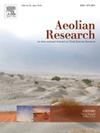Potential PM10 emission from soil affected by different temperatures in a Caldén Forest of semiarid Pampas, Argentina
IF 3.4
3区 地球科学
Q2 GEOGRAPHY, PHYSICAL
引用次数: 0
Abstract
Wind erosion is a major soil degradation process in arid and semi-arid environments, like the semi-arid region of Argentina. Xerophytic Caldén forests in these areas, often experience natural summer fires which reduce vegetation cover and its protective effect on the soil. PM10 (particles with diameters < 10 µm) emission is part of the wind erosion process. In the Caldén forest, cyclically fires affect the physico-chemical properties of the soil, depending on surface temperatures. However, information on how these changes affect soil susceptibility to wind erosion and PM10 emission is limited. This study aimed to evaluate the effect of temperatures from 100 to 600 °C on Caldén forest soil with varying vegetation cover and its potential to emit PM10 (PE-PM10). Soil samples were collected from Grassland site (gramineous-herbaceous stratum without woody plants influence) and Forest site (shrubby and arboreal stratum). The study evaluated physical (texture, microaggregation, erodible fraction < 0.84 mm) and chemical (total organic carbon −TOC-) surface changes and PE-PM10 after exposure to different temperatures. In both sites, temperatures above 400 °C decreased TOC and altered physical properties by reducing clay and coarse sands content while increasing silt and fine sands content. Erodible fraction increased and the microaggregation decreased with rising temperature. PE-PM10 was correlated in a linear and positive way with temperature in both sites (p < 0.05), with highest emission at 600 °C. Grassland site showed higher emissions than Forest. These results suggested that higher temperatures reduced clay and TOC content, key to soil stability, leading to increased PM10 emissions as microaggregates break down.

阿根廷半干旱潘帕斯草原cald森林不同温度对土壤PM10潜在排放的影响
在干旱和半干旱环境中,风蚀是一个主要的土壤退化过程,比如阿根廷的半干旱地区。这些地区的旱生棕树森林经常经历自然的夏季火灾,这减少了植被覆盖及其对土壤的保护作用。PM10(直径为<;10µm)的排放是风蚀过程的一部分。在cald森林中,周期性的火灾会影响土壤的物理化学性质,这取决于地表温度。然而,关于这些变化如何影响土壤对风蚀和PM10排放的易感性的信息有限。本研究旨在评估100 ~ 600℃温度对不同植被覆盖的卡尔卡姆森林区土壤的影响及其释放PM10 (PE-PM10)的潜力。土壤样品采集于草地样地(无木本植物影响的禾本科-草本层)和森林样地(灌木和乔木层)。该研究评估了物理织构、微聚集、可蚀分数;0.84 mm)和化学(总有机碳−TOC-)表面变化和PE-PM10暴露于不同温度后。在这两个地点,高于400°C的温度降低了TOC,改变了物理性质,减少了粘土和粗砂含量,同时增加了粉砂和细砂含量。随着温度的升高,可蚀分数增加,微团聚减少。PE-PM10与两个地点的温度呈线性正相关(p <;0.05),在600°C时辐射最高。草地的排放量高于森林。这些结果表明,较高的温度降低了粘土和TOC含量,这是土壤稳定性的关键,导致微团聚体分解时PM10排放增加。
本文章由计算机程序翻译,如有差异,请以英文原文为准。
求助全文
约1分钟内获得全文
求助全文
来源期刊

Aeolian Research
GEOGRAPHY, PHYSICAL-
CiteScore
7.10
自引率
6.10%
发文量
43
审稿时长
>12 weeks
期刊介绍:
The scope of Aeolian Research includes the following topics:
• Fundamental Aeolian processes, including sand and dust entrainment, transport and deposition of sediment
• Modeling and field studies of Aeolian processes
• Instrumentation/measurement in the field and lab
• Practical applications including environmental impacts and erosion control
• Aeolian landforms, geomorphology and paleoenvironments
• Dust-atmosphere/cloud interactions.
 求助内容:
求助内容: 应助结果提醒方式:
应助结果提醒方式:


